The Role of Bronchodilators in Cystic Fibrosis: A Nursing Perspective
VerifiedAdded on 2022/09/11
|14
|2909
|11
Report
AI Summary
This report provides a comprehensive overview of cystic fibrosis, an autosomal recessive genetic disease primarily affecting the lungs. It details the pathophysiology, focusing on mutations in the CFTR gene and the resulting abnormal transport of sodium and chloride ions, leading to mucus accumulation and respiratory infections. The report then examines salmeterol, a long-acting β2 adrenergic receptor agonist (LABA), as a bronchodilator used in the treatment of cystic fibrosis. It discusses salmeterol's pharmacodynamics, pharmacokinetics, route of administration, indications, contraindications, precautions, side effects, and drug interactions. Furthermore, the report highlights the implications for nursing professionals, emphasizing the importance of understanding the drug's mechanism of action, potential side effects, and patient care considerations to improve patient outcomes. The report concludes by stressing the relevance of this information for nursing practice and the effective care of cystic fibrosis patients.

Running head: NURSING
Cystic Fibrosis and bronchodilators
Name of the Student
Name of the University
Author Note
Cystic Fibrosis and bronchodilators
Name of the Student
Name of the University
Author Note
Paraphrase This Document
Need a fresh take? Get an instant paraphrase of this document with our AI Paraphraser
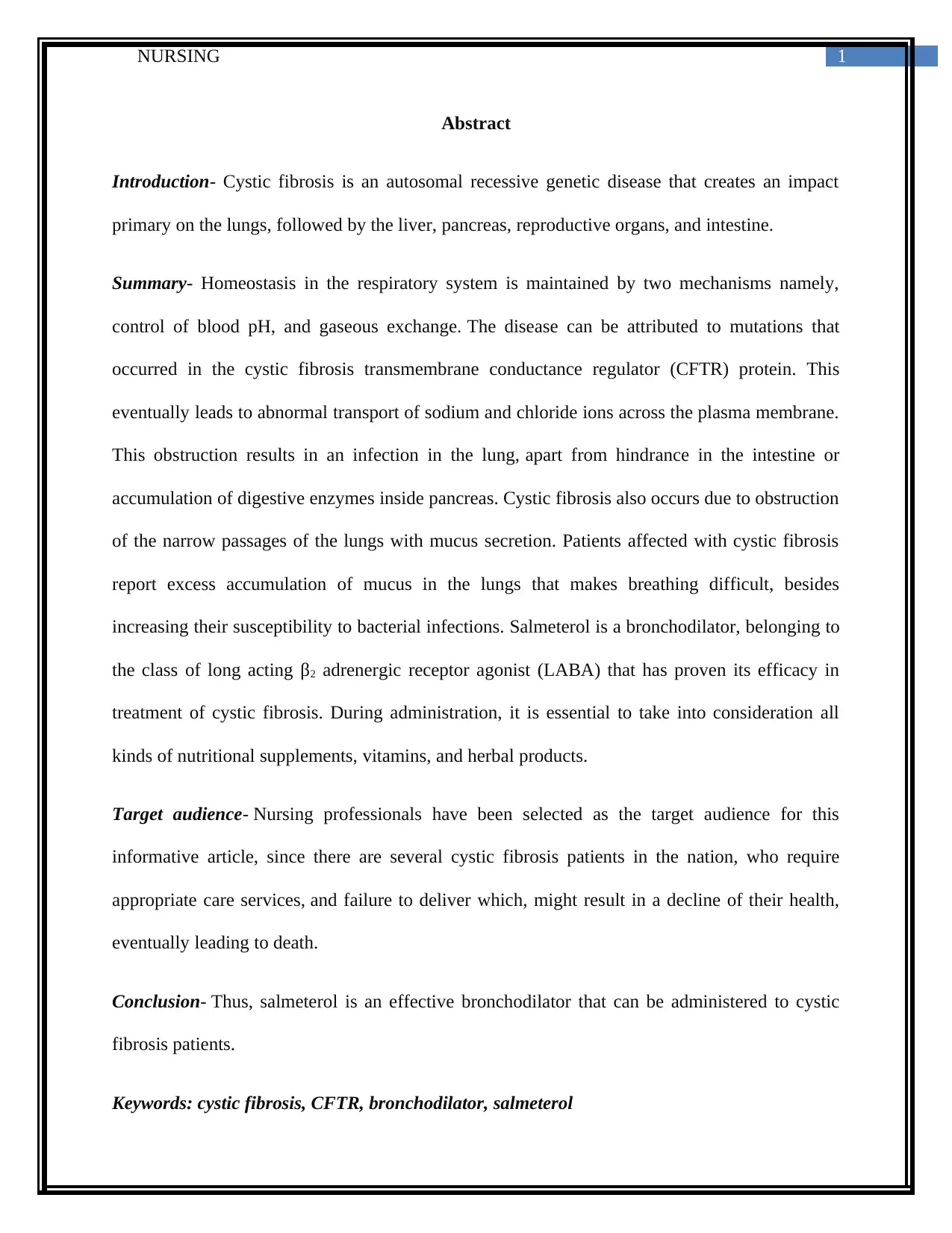
1NURSING
Abstract
Introduction- Cystic fibrosis is an autosomal recessive genetic disease that creates an impact
primary on the lungs, followed by the liver, pancreas, reproductive organs, and intestine.
Summary- Homeostasis in the respiratory system is maintained by two mechanisms namely,
control of blood pH, and gaseous exchange. The disease can be attributed to mutations that
occurred in the cystic fibrosis transmembrane conductance regulator (CFTR) protein. This
eventually leads to abnormal transport of sodium and chloride ions across the plasma membrane.
This obstruction results in an infection in the lung, apart from hindrance in the intestine or
accumulation of digestive enzymes inside pancreas. Cystic fibrosis also occurs due to obstruction
of the narrow passages of the lungs with mucus secretion. Patients affected with cystic fibrosis
report excess accumulation of mucus in the lungs that makes breathing difficult, besides
increasing their susceptibility to bacterial infections. Salmeterol is a bronchodilator, belonging to
the class of long acting β2 adrenergic receptor agonist (LABA) that has proven its efficacy in
treatment of cystic fibrosis. During administration, it is essential to take into consideration all
kinds of nutritional supplements, vitamins, and herbal products.
Target audience- Nursing professionals have been selected as the target audience for this
informative article, since there are several cystic fibrosis patients in the nation, who require
appropriate care services, and failure to deliver which, might result in a decline of their health,
eventually leading to death.
Conclusion- Thus, salmeterol is an effective bronchodilator that can be administered to cystic
fibrosis patients.
Keywords: cystic fibrosis, CFTR, bronchodilator, salmeterol
Abstract
Introduction- Cystic fibrosis is an autosomal recessive genetic disease that creates an impact
primary on the lungs, followed by the liver, pancreas, reproductive organs, and intestine.
Summary- Homeostasis in the respiratory system is maintained by two mechanisms namely,
control of blood pH, and gaseous exchange. The disease can be attributed to mutations that
occurred in the cystic fibrosis transmembrane conductance regulator (CFTR) protein. This
eventually leads to abnormal transport of sodium and chloride ions across the plasma membrane.
This obstruction results in an infection in the lung, apart from hindrance in the intestine or
accumulation of digestive enzymes inside pancreas. Cystic fibrosis also occurs due to obstruction
of the narrow passages of the lungs with mucus secretion. Patients affected with cystic fibrosis
report excess accumulation of mucus in the lungs that makes breathing difficult, besides
increasing their susceptibility to bacterial infections. Salmeterol is a bronchodilator, belonging to
the class of long acting β2 adrenergic receptor agonist (LABA) that has proven its efficacy in
treatment of cystic fibrosis. During administration, it is essential to take into consideration all
kinds of nutritional supplements, vitamins, and herbal products.
Target audience- Nursing professionals have been selected as the target audience for this
informative article, since there are several cystic fibrosis patients in the nation, who require
appropriate care services, and failure to deliver which, might result in a decline of their health,
eventually leading to death.
Conclusion- Thus, salmeterol is an effective bronchodilator that can be administered to cystic
fibrosis patients.
Keywords: cystic fibrosis, CFTR, bronchodilator, salmeterol
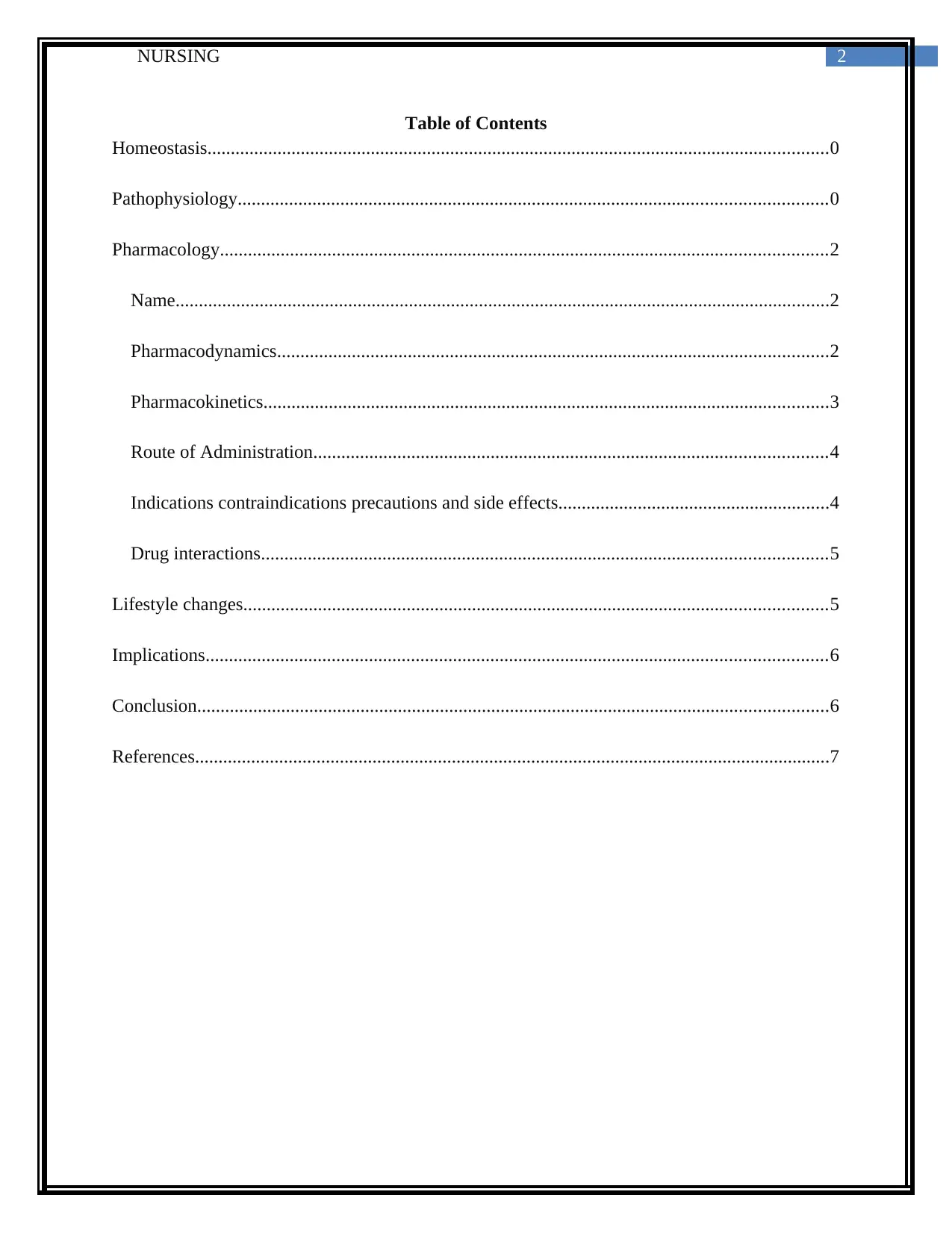
2NURSING
Table of Contents
Homeostasis.....................................................................................................................................0
Pathophysiology..............................................................................................................................0
Pharmacology..................................................................................................................................2
Name............................................................................................................................................2
Pharmacodynamics......................................................................................................................2
Pharmacokinetics.........................................................................................................................3
Route of Administration..............................................................................................................4
Indications contraindications precautions and side effects..........................................................4
Drug interactions.........................................................................................................................5
Lifestyle changes.............................................................................................................................5
Implications.....................................................................................................................................6
Conclusion.......................................................................................................................................6
References........................................................................................................................................7
Table of Contents
Homeostasis.....................................................................................................................................0
Pathophysiology..............................................................................................................................0
Pharmacology..................................................................................................................................2
Name............................................................................................................................................2
Pharmacodynamics......................................................................................................................2
Pharmacokinetics.........................................................................................................................3
Route of Administration..............................................................................................................4
Indications contraindications precautions and side effects..........................................................4
Drug interactions.........................................................................................................................5
Lifestyle changes.............................................................................................................................5
Implications.....................................................................................................................................6
Conclusion.......................................................................................................................................6
References........................................................................................................................................7
⊘ This is a preview!⊘
Do you want full access?
Subscribe today to unlock all pages.

Trusted by 1+ million students worldwide

3NURSING
Homeostasis
Gaseous exchange occurs inside the
lungs that leads to elimination of carbon
dioxide during cellular respiration,
following which oxygen enters the body for
providing energy required for the
physiological functions, like muscle
contraction and nerve conduction. Absence
of oxygen creates an impact on functioning
of the brain, heart and sense of judgment as
well. Exchange of gases inside the lungs
also helps in maintaining acid base
equilibrium in the body (Hall, 2016). When
the pH of the blood becomes acidic, an
augmentation occurs in the breathing rate
that decreases the amount of carbon dioxide
present in the circulating bloodstream, thus
restoring the pH to normal level. Similarly
alkaline blood leads to a lessening in
breathing, thus increasing the amount of
carbon dioxide present, which helps in
decreasing the pH.
Figure 1- Respiratory unit
Source- (Hall, 2016)
Pathophysiology
Cystic fibrosis refers to a genetic
disease that predominantly creates an impact
on the lungs, but also affects the liver,
kidney, intestine, and the pancreas. Research
evidences have identified numerous
mutations in the CFTR gene that lead to the
development of defects in CFTR protein,
eventually causing disease. There is
mounting evidence for the fact that ΔF508-
CFTR is present in several patients that
results in the synthesis of a protein, which
Homeostasis
Gaseous exchange occurs inside the
lungs that leads to elimination of carbon
dioxide during cellular respiration,
following which oxygen enters the body for
providing energy required for the
physiological functions, like muscle
contraction and nerve conduction. Absence
of oxygen creates an impact on functioning
of the brain, heart and sense of judgment as
well. Exchange of gases inside the lungs
also helps in maintaining acid base
equilibrium in the body (Hall, 2016). When
the pH of the blood becomes acidic, an
augmentation occurs in the breathing rate
that decreases the amount of carbon dioxide
present in the circulating bloodstream, thus
restoring the pH to normal level. Similarly
alkaline blood leads to a lessening in
breathing, thus increasing the amount of
carbon dioxide present, which helps in
decreasing the pH.
Figure 1- Respiratory unit
Source- (Hall, 2016)
Pathophysiology
Cystic fibrosis refers to a genetic
disease that predominantly creates an impact
on the lungs, but also affects the liver,
kidney, intestine, and the pancreas. Research
evidences have identified numerous
mutations in the CFTR gene that lead to the
development of defects in CFTR protein,
eventually causing disease. There is
mounting evidence for the fact that ΔF508-
CFTR is present in several patients that
results in the synthesis of a protein, which
Paraphrase This Document
Need a fresh take? Get an instant paraphrase of this document with our AI Paraphraser
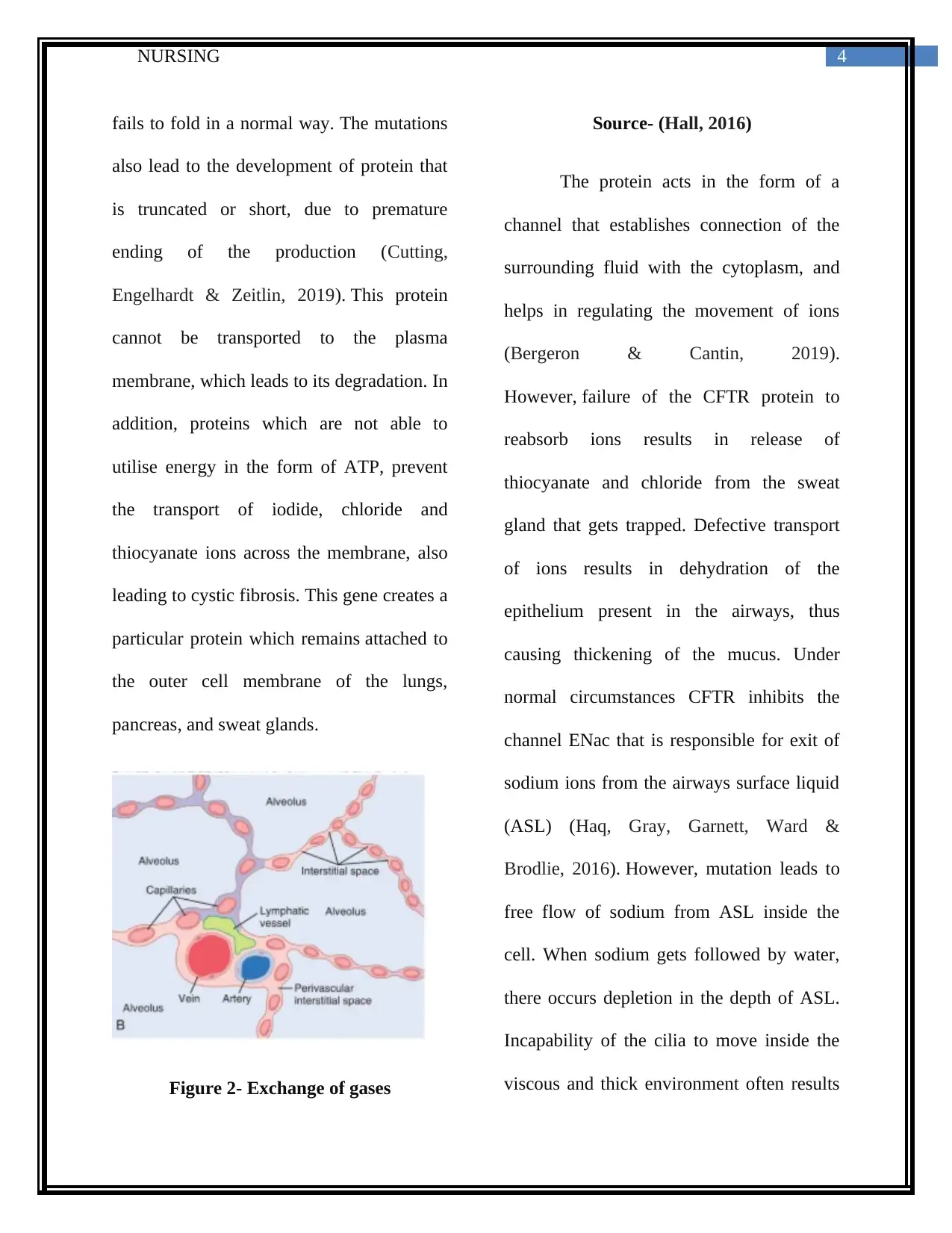
4NURSING
fails to fold in a normal way. The mutations
also lead to the development of protein that
is truncated or short, due to premature
ending of the production (Cutting,
Engelhardt & Zeitlin, 2019). This protein
cannot be transported to the plasma
membrane, which leads to its degradation. In
addition, proteins which are not able to
utilise energy in the form of ATP, prevent
the transport of iodide, chloride and
thiocyanate ions across the membrane, also
leading to cystic fibrosis. This gene creates a
particular protein which remains attached to
the outer cell membrane of the lungs,
pancreas, and sweat glands.
Figure 2- Exchange of gases
Source- (Hall, 2016)
The protein acts in the form of a
channel that establishes connection of the
surrounding fluid with the cytoplasm, and
helps in regulating the movement of ions
(Bergeron & Cantin, 2019).
However, failure of the CFTR protein to
reabsorb ions results in release of
thiocyanate and chloride from the sweat
gland that gets trapped. Defective transport
of ions results in dehydration of the
epithelium present in the airways, thus
causing thickening of the mucus. Under
normal circumstances CFTR inhibits the
channel ENac that is responsible for exit of
sodium ions from the airways surface liquid
(ASL) (Haq, Gray, Garnett, Ward &
Brodlie, 2016). However, mutation leads to
free flow of sodium from ASL inside the
cell. When sodium gets followed by water,
there occurs depletion in the depth of ASL.
Incapability of the cilia to move inside the
viscous and thick environment often results
fails to fold in a normal way. The mutations
also lead to the development of protein that
is truncated or short, due to premature
ending of the production (Cutting,
Engelhardt & Zeitlin, 2019). This protein
cannot be transported to the plasma
membrane, which leads to its degradation. In
addition, proteins which are not able to
utilise energy in the form of ATP, prevent
the transport of iodide, chloride and
thiocyanate ions across the membrane, also
leading to cystic fibrosis. This gene creates a
particular protein which remains attached to
the outer cell membrane of the lungs,
pancreas, and sweat glands.
Figure 2- Exchange of gases
Source- (Hall, 2016)
The protein acts in the form of a
channel that establishes connection of the
surrounding fluid with the cytoplasm, and
helps in regulating the movement of ions
(Bergeron & Cantin, 2019).
However, failure of the CFTR protein to
reabsorb ions results in release of
thiocyanate and chloride from the sweat
gland that gets trapped. Defective transport
of ions results in dehydration of the
epithelium present in the airways, thus
causing thickening of the mucus. Under
normal circumstances CFTR inhibits the
channel ENac that is responsible for exit of
sodium ions from the airways surface liquid
(ASL) (Haq, Gray, Garnett, Ward &
Brodlie, 2016). However, mutation leads to
free flow of sodium from ASL inside the
cell. When sodium gets followed by water,
there occurs depletion in the depth of ASL.
Incapability of the cilia to move inside the
viscous and thick environment often results
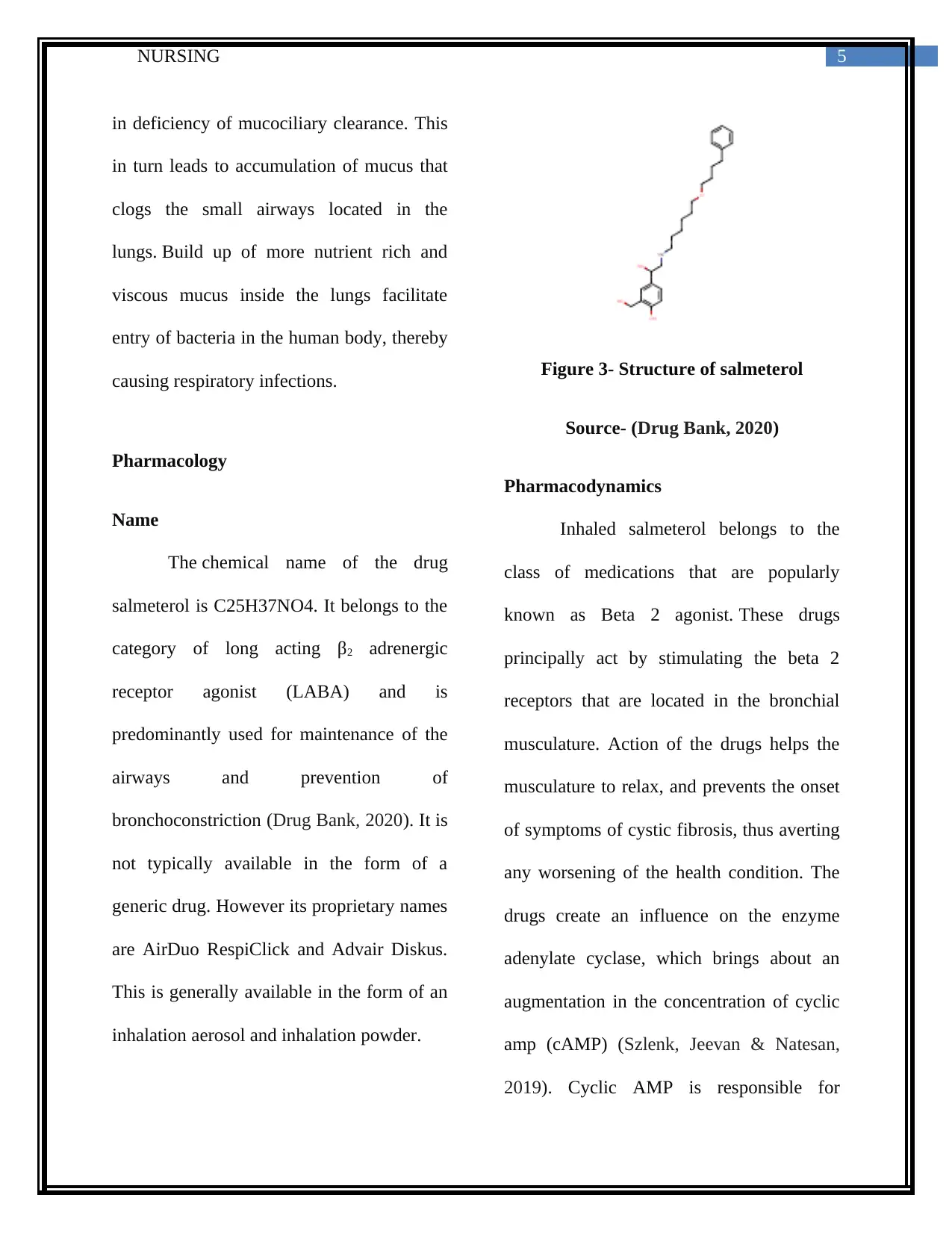
5NURSING
in deficiency of mucociliary clearance. This
in turn leads to accumulation of mucus that
clogs the small airways located in the
lungs. Build up of more nutrient rich and
viscous mucus inside the lungs facilitate
entry of bacteria in the human body, thereby
causing respiratory infections.
Pharmacology
Name
The chemical name of the drug
salmeterol is C25H37NO4. It belongs to the
category of long acting β2 adrenergic
receptor agonist (LABA) and is
predominantly used for maintenance of the
airways and prevention of
bronchoconstriction (Drug Bank, 2020). It is
not typically available in the form of a
generic drug. However its proprietary names
are AirDuo RespiClick and Advair Diskus.
This is generally available in the form of an
inhalation aerosol and inhalation powder.
Figure 3- Structure of salmeterol
Source- (Drug Bank, 2020)
Pharmacodynamics
Inhaled salmeterol belongs to the
class of medications that are popularly
known as Beta 2 agonist. These drugs
principally act by stimulating the beta 2
receptors that are located in the bronchial
musculature. Action of the drugs helps the
musculature to relax, and prevents the onset
of symptoms of cystic fibrosis, thus averting
any worsening of the health condition. The
drugs create an influence on the enzyme
adenylate cyclase, which brings about an
augmentation in the concentration of cyclic
amp (cAMP) (Szlenk, Jeevan & Natesan,
2019). Cyclic AMP is responsible for
in deficiency of mucociliary clearance. This
in turn leads to accumulation of mucus that
clogs the small airways located in the
lungs. Build up of more nutrient rich and
viscous mucus inside the lungs facilitate
entry of bacteria in the human body, thereby
causing respiratory infections.
Pharmacology
Name
The chemical name of the drug
salmeterol is C25H37NO4. It belongs to the
category of long acting β2 adrenergic
receptor agonist (LABA) and is
predominantly used for maintenance of the
airways and prevention of
bronchoconstriction (Drug Bank, 2020). It is
not typically available in the form of a
generic drug. However its proprietary names
are AirDuo RespiClick and Advair Diskus.
This is generally available in the form of an
inhalation aerosol and inhalation powder.
Figure 3- Structure of salmeterol
Source- (Drug Bank, 2020)
Pharmacodynamics
Inhaled salmeterol belongs to the
class of medications that are popularly
known as Beta 2 agonist. These drugs
principally act by stimulating the beta 2
receptors that are located in the bronchial
musculature. Action of the drugs helps the
musculature to relax, and prevents the onset
of symptoms of cystic fibrosis, thus averting
any worsening of the health condition. The
drugs create an influence on the enzyme
adenylate cyclase, which brings about an
augmentation in the concentration of cyclic
amp (cAMP) (Szlenk, Jeevan & Natesan,
2019). Cyclic AMP is responsible for
⊘ This is a preview!⊘
Do you want full access?
Subscribe today to unlock all pages.

Trusted by 1+ million students worldwide
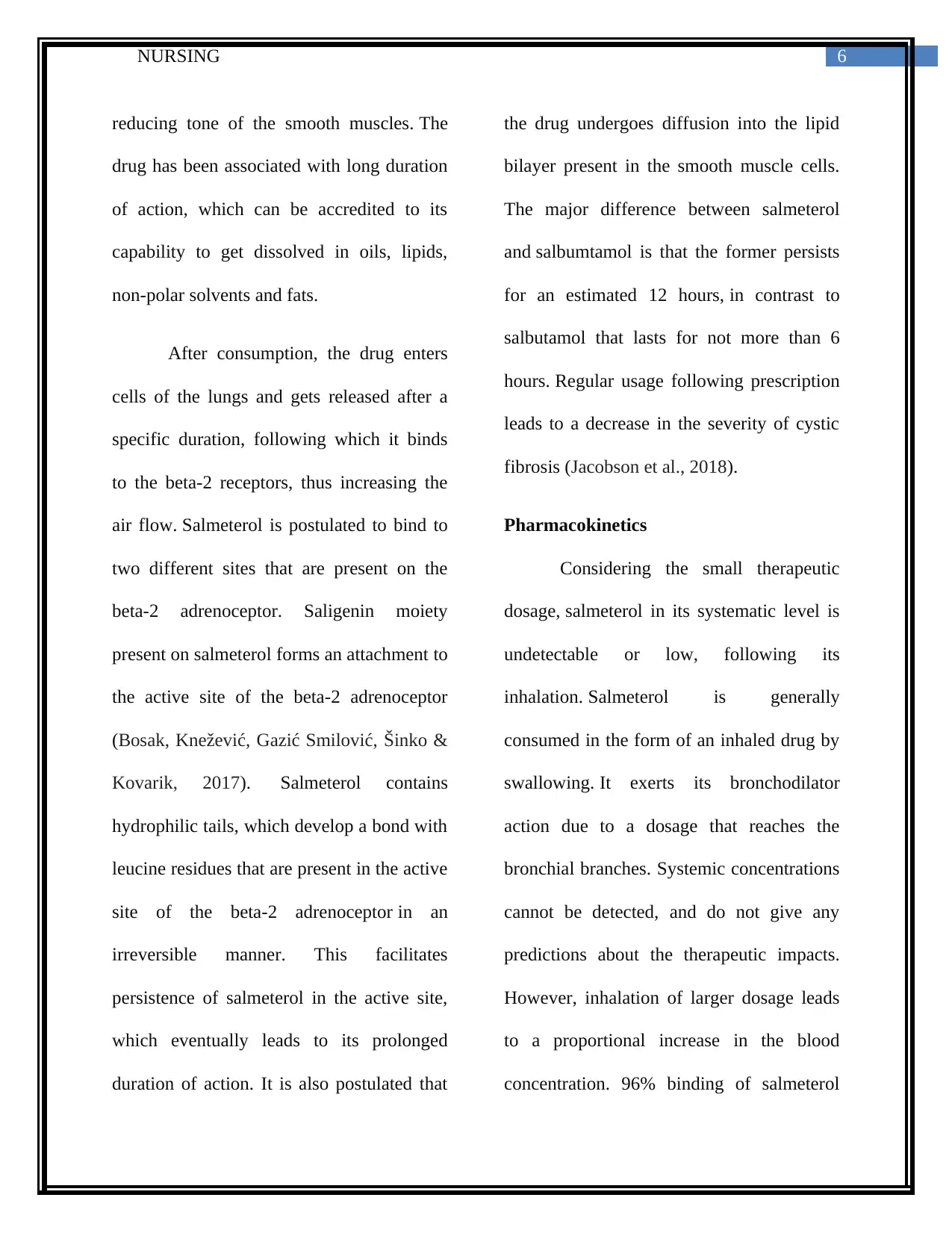
6NURSING
reducing tone of the smooth muscles. The
drug has been associated with long duration
of action, which can be accredited to its
capability to get dissolved in oils, lipids,
non-polar solvents and fats.
After consumption, the drug enters
cells of the lungs and gets released after a
specific duration, following which it binds
to the beta-2 receptors, thus increasing the
air flow. Salmeterol is postulated to bind to
two different sites that are present on the
beta-2 adrenoceptor. Saligenin moiety
present on salmeterol forms an attachment to
the active site of the beta-2 adrenoceptor
(Bosak, Knežević, Gazić Smilović, Šinko &
Kovarik, 2017). Salmeterol contains
hydrophilic tails, which develop a bond with
leucine residues that are present in the active
site of the beta-2 adrenoceptor in an
irreversible manner. This facilitates
persistence of salmeterol in the active site,
which eventually leads to its prolonged
duration of action. It is also postulated that
the drug undergoes diffusion into the lipid
bilayer present in the smooth muscle cells.
The major difference between salmeterol
and salbumtamol is that the former persists
for an estimated 12 hours, in contrast to
salbutamol that lasts for not more than 6
hours. Regular usage following prescription
leads to a decrease in the severity of cystic
fibrosis (Jacobson et al., 2018).
Pharmacokinetics
Considering the small therapeutic
dosage, salmeterol in its systematic level is
undetectable or low, following its
inhalation. Salmeterol is generally
consumed in the form of an inhaled drug by
swallowing. It exerts its bronchodilator
action due to a dosage that reaches the
bronchial branches. Systemic concentrations
cannot be detected, and do not give any
predictions about the therapeutic impacts.
However, inhalation of larger dosage leads
to a proportional increase in the blood
concentration. 96% binding of salmeterol
reducing tone of the smooth muscles. The
drug has been associated with long duration
of action, which can be accredited to its
capability to get dissolved in oils, lipids,
non-polar solvents and fats.
After consumption, the drug enters
cells of the lungs and gets released after a
specific duration, following which it binds
to the beta-2 receptors, thus increasing the
air flow. Salmeterol is postulated to bind to
two different sites that are present on the
beta-2 adrenoceptor. Saligenin moiety
present on salmeterol forms an attachment to
the active site of the beta-2 adrenoceptor
(Bosak, Knežević, Gazić Smilović, Šinko &
Kovarik, 2017). Salmeterol contains
hydrophilic tails, which develop a bond with
leucine residues that are present in the active
site of the beta-2 adrenoceptor in an
irreversible manner. This facilitates
persistence of salmeterol in the active site,
which eventually leads to its prolonged
duration of action. It is also postulated that
the drug undergoes diffusion into the lipid
bilayer present in the smooth muscle cells.
The major difference between salmeterol
and salbumtamol is that the former persists
for an estimated 12 hours, in contrast to
salbutamol that lasts for not more than 6
hours. Regular usage following prescription
leads to a decrease in the severity of cystic
fibrosis (Jacobson et al., 2018).
Pharmacokinetics
Considering the small therapeutic
dosage, salmeterol in its systematic level is
undetectable or low, following its
inhalation. Salmeterol is generally
consumed in the form of an inhaled drug by
swallowing. It exerts its bronchodilator
action due to a dosage that reaches the
bronchial branches. Systemic concentrations
cannot be detected, and do not give any
predictions about the therapeutic impacts.
However, inhalation of larger dosage leads
to a proportional increase in the blood
concentration. 96% binding of salmeterol
Paraphrase This Document
Need a fresh take? Get an instant paraphrase of this document with our AI Paraphraser

7NURSING
occurs to the human plasma protein, in
relation to a concentration that ranges from
8-7722 ng/mL (Drug Bank, 2020).
Salmeterol remains bound to alpha 1 acid
glycoprotein and albumin, and 99% of the
xinafoate moiety remains bound to albumin.
However, research evidence suggests that
salmeterol is able to cross the blood brain
barrier in minute amount. 50μg dosage of
inhaled salmeterol attains 47.897pg/mL
Cmax, with AUC of 156.041pg/mL/h and a
Tmax of 0.240h (NCBI, 2020).
The volume of distribution of this
particular drug’s central compartment has
been found to be 177L and, that of the
peripheral compartment is approximately
3160L. the drug is predominantly
metabolized to alpha-hydroxysalmeterol by
CYP3A4. In addition, the metabolism is also
associated with the generation of a product
O-dealkylated metabolite, through a
mechanism that is unknown. 57.4%
salmeterol gets eliminated in fecal matter
with the remaining 23% eliminating in the
form of urine (U.S. National Library of
Medicine, 2020). Not more than 5% of the
inhaled dosage also gets eliminated in urine
in the form of unchanged salmeterol. The
drug has a half-life of approximately 5.5
hours, and 392L/h average clearance.
However, there is lack of information about
the clearance of salmeterol.
Route of Administration
The drug is available in the form of a
dry powder that is generally inhaled through
the mouth, with the use of a particularly
designed inhaler.
Indications contraindications precautions
and side effects
Administration of the drug
is particularly indicated for the management
of cystic fibrosis and asthma. Its indication
focuses on usage for maintenance of airflow
obstruction. In addition, it is also used for
preventing for the exacerbation of any
pulmonary disease. It is generally used for
occurs to the human plasma protein, in
relation to a concentration that ranges from
8-7722 ng/mL (Drug Bank, 2020).
Salmeterol remains bound to alpha 1 acid
glycoprotein and albumin, and 99% of the
xinafoate moiety remains bound to albumin.
However, research evidence suggests that
salmeterol is able to cross the blood brain
barrier in minute amount. 50μg dosage of
inhaled salmeterol attains 47.897pg/mL
Cmax, with AUC of 156.041pg/mL/h and a
Tmax of 0.240h (NCBI, 2020).
The volume of distribution of this
particular drug’s central compartment has
been found to be 177L and, that of the
peripheral compartment is approximately
3160L. the drug is predominantly
metabolized to alpha-hydroxysalmeterol by
CYP3A4. In addition, the metabolism is also
associated with the generation of a product
O-dealkylated metabolite, through a
mechanism that is unknown. 57.4%
salmeterol gets eliminated in fecal matter
with the remaining 23% eliminating in the
form of urine (U.S. National Library of
Medicine, 2020). Not more than 5% of the
inhaled dosage also gets eliminated in urine
in the form of unchanged salmeterol. The
drug has a half-life of approximately 5.5
hours, and 392L/h average clearance.
However, there is lack of information about
the clearance of salmeterol.
Route of Administration
The drug is available in the form of a
dry powder that is generally inhaled through
the mouth, with the use of a particularly
designed inhaler.
Indications contraindications precautions
and side effects
Administration of the drug
is particularly indicated for the management
of cystic fibrosis and asthma. Its indication
focuses on usage for maintenance of airflow
obstruction. In addition, it is also used for
preventing for the exacerbation of any
pulmonary disease. It is generally used for

8NURSING
individuals aged 18 years or
more. Salmeterol drugs should not be
administered to patients who suffer from any
of the following conditions like diabetes,
thyrotoxicosis, high blood pressure,
seizures, or reduced flow of blood through
the arteries located in the heart (Blair,
2019). It is generally not advised to
administer salmeterol amongst those who
report the presence of low potassium in
circulating bloodstream. People reporting
abnormal EKG with QT variations or those
with long QT interval are generally not
administered this drug.
Drug interactions
While administering the drug, it is
essential for a physician to check if the
patient has any hypersensitivity towards beta
adrenergic agents. Further precautions
include disclosing information about the
consumption of any other drugs like
arformoterol, fluticasone, indacaterol
or vilanterol (Remien & Bowman, 2019).
Any instances of irregular heartbeat, loss of
consciousness, cardiovascular disease, or
reports of pregnancy or breastfeeding must
be shared with the physician, prior to
medication administration (Gonzalez-
Estrada & Geraci, 2016). Side effects of the
medication include dizziness, migraine
headache, sinus infection, hypokalemia,
muscle tremor and worsening of breathing
problems.
Lifestyle changes
The major lifestyle modifications
that can prevent worsening of health of
patients diagnosed with cystic fibrosis
include smoking suggestion, regular
exercise, and consumption of fluids, chest
physical therapy, and regular washing of
hands in order to prevent infection. Smoking
results in chronic bronchitis and COPD, and
increases the chances of cystic fibrosis
(Kopp et al., 2019). Regular physical
activity will not only strengthen the bones
and enhance lungs function, but also play an
individuals aged 18 years or
more. Salmeterol drugs should not be
administered to patients who suffer from any
of the following conditions like diabetes,
thyrotoxicosis, high blood pressure,
seizures, or reduced flow of blood through
the arteries located in the heart (Blair,
2019). It is generally not advised to
administer salmeterol amongst those who
report the presence of low potassium in
circulating bloodstream. People reporting
abnormal EKG with QT variations or those
with long QT interval are generally not
administered this drug.
Drug interactions
While administering the drug, it is
essential for a physician to check if the
patient has any hypersensitivity towards beta
adrenergic agents. Further precautions
include disclosing information about the
consumption of any other drugs like
arformoterol, fluticasone, indacaterol
or vilanterol (Remien & Bowman, 2019).
Any instances of irregular heartbeat, loss of
consciousness, cardiovascular disease, or
reports of pregnancy or breastfeeding must
be shared with the physician, prior to
medication administration (Gonzalez-
Estrada & Geraci, 2016). Side effects of the
medication include dizziness, migraine
headache, sinus infection, hypokalemia,
muscle tremor and worsening of breathing
problems.
Lifestyle changes
The major lifestyle modifications
that can prevent worsening of health of
patients diagnosed with cystic fibrosis
include smoking suggestion, regular
exercise, and consumption of fluids, chest
physical therapy, and regular washing of
hands in order to prevent infection. Smoking
results in chronic bronchitis and COPD, and
increases the chances of cystic fibrosis
(Kopp et al., 2019). Regular physical
activity will not only strengthen the bones
and enhance lungs function, but also play an
⊘ This is a preview!⊘
Do you want full access?
Subscribe today to unlock all pages.

Trusted by 1+ million students worldwide
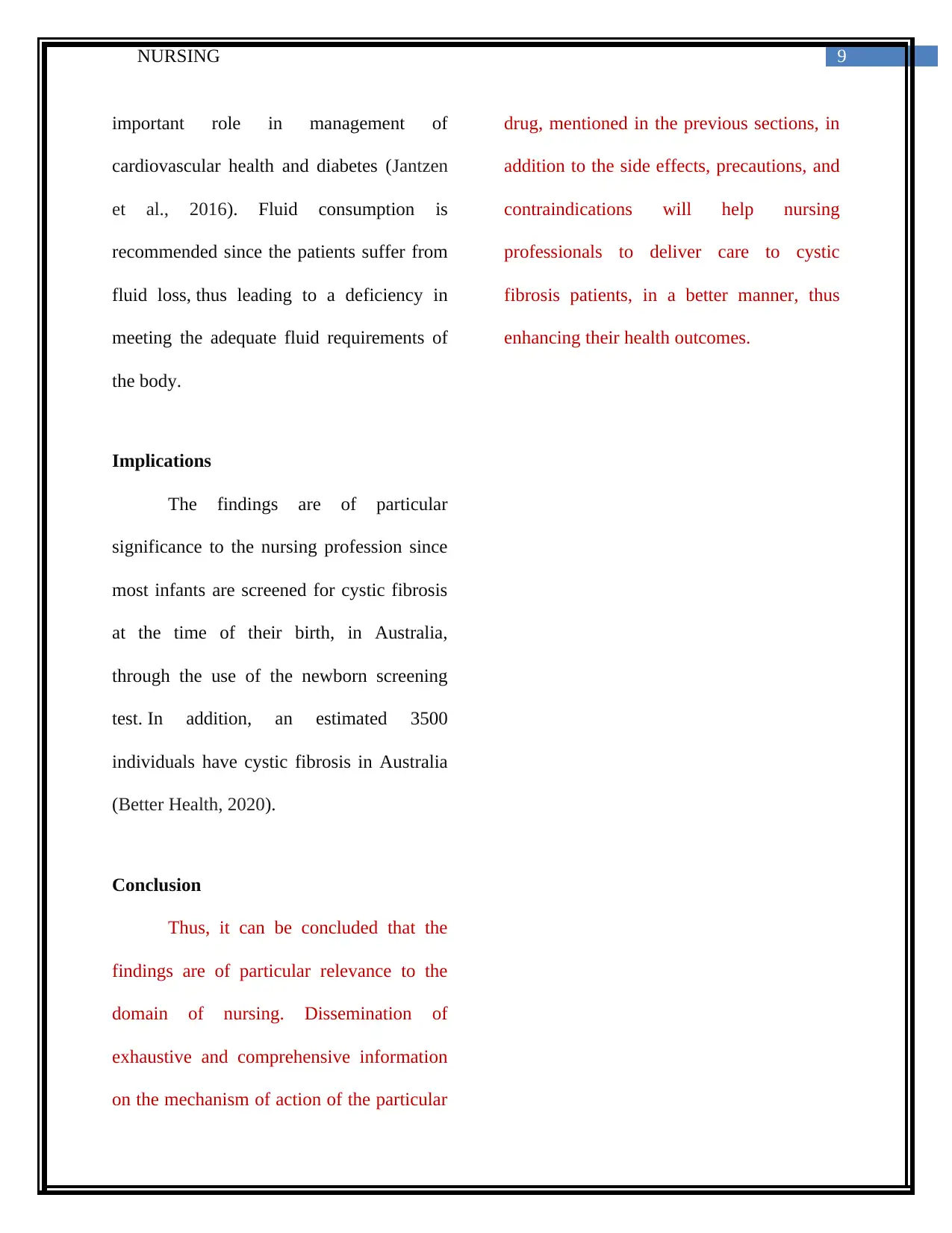
9NURSING
important role in management of
cardiovascular health and diabetes (Jantzen
et al., 2016). Fluid consumption is
recommended since the patients suffer from
fluid loss, thus leading to a deficiency in
meeting the adequate fluid requirements of
the body.
Implications
The findings are of particular
significance to the nursing profession since
most infants are screened for cystic fibrosis
at the time of their birth, in Australia,
through the use of the newborn screening
test. In addition, an estimated 3500
individuals have cystic fibrosis in Australia
(Better Health, 2020).
Conclusion
Thus, it can be concluded that the
findings are of particular relevance to the
domain of nursing. Dissemination of
exhaustive and comprehensive information
on the mechanism of action of the particular
drug, mentioned in the previous sections, in
addition to the side effects, precautions, and
contraindications will help nursing
professionals to deliver care to cystic
fibrosis patients, in a better manner, thus
enhancing their health outcomes.
important role in management of
cardiovascular health and diabetes (Jantzen
et al., 2016). Fluid consumption is
recommended since the patients suffer from
fluid loss, thus leading to a deficiency in
meeting the adequate fluid requirements of
the body.
Implications
The findings are of particular
significance to the nursing profession since
most infants are screened for cystic fibrosis
at the time of their birth, in Australia,
through the use of the newborn screening
test. In addition, an estimated 3500
individuals have cystic fibrosis in Australia
(Better Health, 2020).
Conclusion
Thus, it can be concluded that the
findings are of particular relevance to the
domain of nursing. Dissemination of
exhaustive and comprehensive information
on the mechanism of action of the particular
drug, mentioned in the previous sections, in
addition to the side effects, precautions, and
contraindications will help nursing
professionals to deliver care to cystic
fibrosis patients, in a better manner, thus
enhancing their health outcomes.
Paraphrase This Document
Need a fresh take? Get an instant paraphrase of this document with our AI Paraphraser
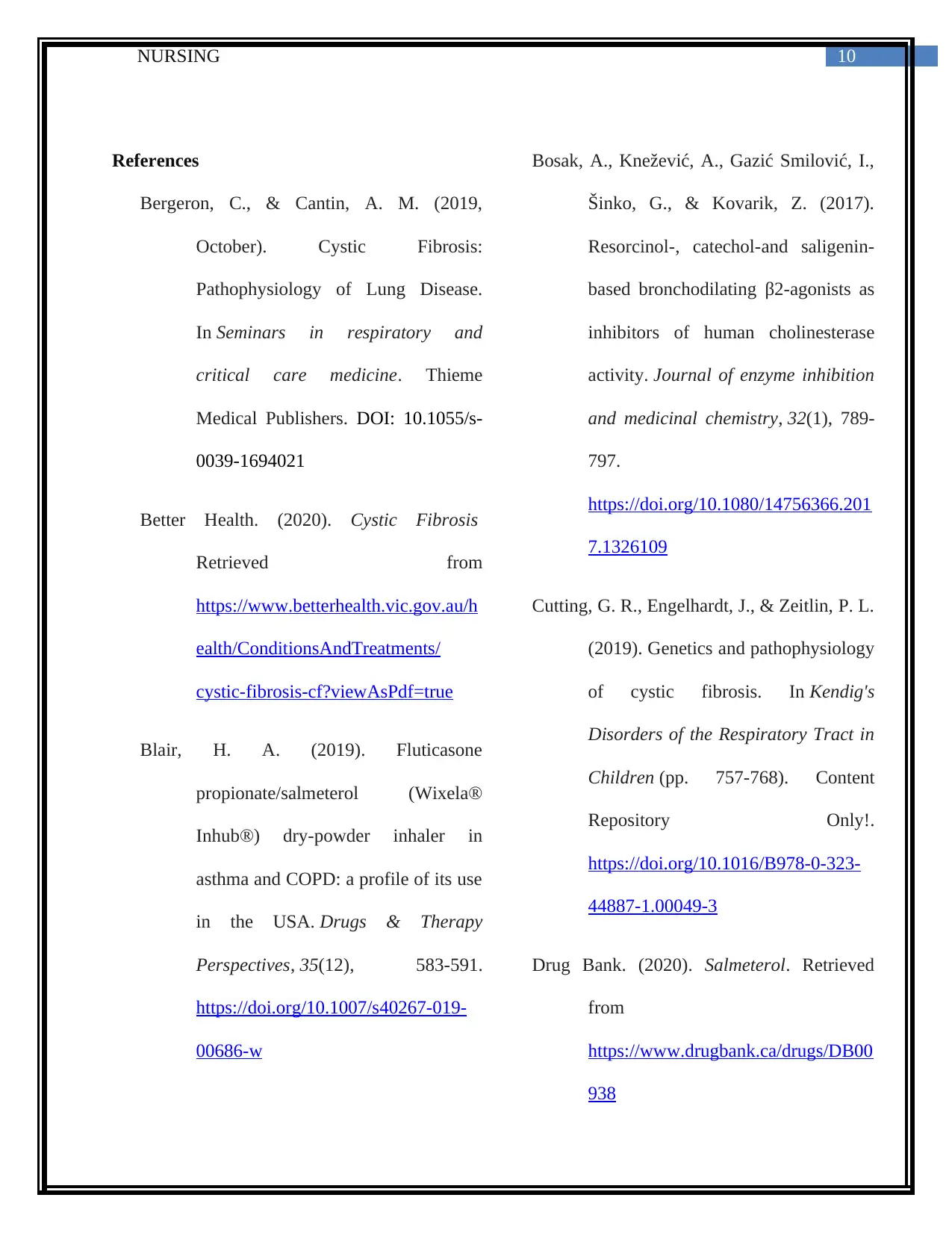
10NURSING
References
Bergeron, C., & Cantin, A. M. (2019,
October). Cystic Fibrosis:
Pathophysiology of Lung Disease.
In Seminars in respiratory and
critical care medicine. Thieme
Medical Publishers. DOI: 10.1055/s-
0039-1694021
Better Health. (2020). Cystic Fibrosis
Retrieved from
https://www.betterhealth.vic.gov.au/h
ealth/ConditionsAndTreatments/
cystic-fibrosis-cf?viewAsPdf=true
Blair, H. A. (2019). Fluticasone
propionate/salmeterol (Wixela®
Inhub®) dry-powder inhaler in
asthma and COPD: a profile of its use
in the USA. Drugs & Therapy
Perspectives, 35(12), 583-591.
https://doi.org/10.1007/s40267-019-
00686-w
Bosak, A., Knežević, A., Gazić Smilović, I.,
Šinko, G., & Kovarik, Z. (2017).
Resorcinol-, catechol-and saligenin-
based bronchodilating β2-agonists as
inhibitors of human cholinesterase
activity. Journal of enzyme inhibition
and medicinal chemistry, 32(1), 789-
797.
https://doi.org/10.1080/14756366.201
7.1326109
Cutting, G. R., Engelhardt, J., & Zeitlin, P. L.
(2019). Genetics and pathophysiology
of cystic fibrosis. In Kendig's
Disorders of the Respiratory Tract in
Children (pp. 757-768). Content
Repository Only!.
https://doi.org/10.1016/B978-0-323-
44887-1.00049-3
Drug Bank. (2020). Salmeterol. Retrieved
from
https://www.drugbank.ca/drugs/DB00
938
References
Bergeron, C., & Cantin, A. M. (2019,
October). Cystic Fibrosis:
Pathophysiology of Lung Disease.
In Seminars in respiratory and
critical care medicine. Thieme
Medical Publishers. DOI: 10.1055/s-
0039-1694021
Better Health. (2020). Cystic Fibrosis
Retrieved from
https://www.betterhealth.vic.gov.au/h
ealth/ConditionsAndTreatments/
cystic-fibrosis-cf?viewAsPdf=true
Blair, H. A. (2019). Fluticasone
propionate/salmeterol (Wixela®
Inhub®) dry-powder inhaler in
asthma and COPD: a profile of its use
in the USA. Drugs & Therapy
Perspectives, 35(12), 583-591.
https://doi.org/10.1007/s40267-019-
00686-w
Bosak, A., Knežević, A., Gazić Smilović, I.,
Šinko, G., & Kovarik, Z. (2017).
Resorcinol-, catechol-and saligenin-
based bronchodilating β2-agonists as
inhibitors of human cholinesterase
activity. Journal of enzyme inhibition
and medicinal chemistry, 32(1), 789-
797.
https://doi.org/10.1080/14756366.201
7.1326109
Cutting, G. R., Engelhardt, J., & Zeitlin, P. L.
(2019). Genetics and pathophysiology
of cystic fibrosis. In Kendig's
Disorders of the Respiratory Tract in
Children (pp. 757-768). Content
Repository Only!.
https://doi.org/10.1016/B978-0-323-
44887-1.00049-3
Drug Bank. (2020). Salmeterol. Retrieved
from
https://www.drugbank.ca/drugs/DB00
938

11NURSING
Gonzalez-Estrada, A., & Geraci, S. A.
(2016). Allergy medications during
pregnancy. The American journal of
the medical sciences, 352(3), 326-
331.
https://doi.org/10.1016/j.amjms.2016.
05.030
Hall, J. E. (2016). Guyton and Hall Textbook
of Medical Physiology, Jordanian
Edition E-Book. Elsevier. Retrieved
from
https://books.google.co.in/books?
hl=en&lr=&id=qyfRDwAAQBAJ&oi
=fnd&pg=PP1&dq=guyton+and+hall
&ots=r16I3cBf7o&sig=7tptmbzEqdJ
27LzHymFjQpu1UEY&redir_esc=y#
v=onepage&q=guyton%20and
%20hall&f=false
Haq, I. J., Gray, M. A., Garnett, J. P., Ward,
C., & Brodlie, M. (2016). Airway
surface liquid homeostasis in cystic
fibrosis: pathophysiology and
therapeutic targets. Thorax, 71(3),
284-287.
http://dx.doi.org/10.1136/thoraxjnl-
2015-207588
Jacobson, G. A., Raidal, S., Robson, K.,
Narkowicz, C. K., Nichols, D. S., &
Walters, E. H. (2018). Salmeterol
undergoes enantioselective
bronchopulmonary distribution with
receptor localisation a likely
determinant of duration of
action. Journal of pharmaceutical and
biomedical analysis, 154, 102-107.
https://doi.org/10.1016/j.jpba.2018.02
.048
Jantzen, A., Opoku‐Pare, M., Bieli, C., Ruf,
K., Hebestreit, H., & Moeller, A.
(2016). Perspective on cystic fibrosis
and physical activity: is there a
difference compared to healthy
individuals?. Pediatric
pulmonology, 51(10), 1020-1030.
https://doi.org/10.1002/ppul.23532
Gonzalez-Estrada, A., & Geraci, S. A.
(2016). Allergy medications during
pregnancy. The American journal of
the medical sciences, 352(3), 326-
331.
https://doi.org/10.1016/j.amjms.2016.
05.030
Hall, J. E. (2016). Guyton and Hall Textbook
of Medical Physiology, Jordanian
Edition E-Book. Elsevier. Retrieved
from
https://books.google.co.in/books?
hl=en&lr=&id=qyfRDwAAQBAJ&oi
=fnd&pg=PP1&dq=guyton+and+hall
&ots=r16I3cBf7o&sig=7tptmbzEqdJ
27LzHymFjQpu1UEY&redir_esc=y#
v=onepage&q=guyton%20and
%20hall&f=false
Haq, I. J., Gray, M. A., Garnett, J. P., Ward,
C., & Brodlie, M. (2016). Airway
surface liquid homeostasis in cystic
fibrosis: pathophysiology and
therapeutic targets. Thorax, 71(3),
284-287.
http://dx.doi.org/10.1136/thoraxjnl-
2015-207588
Jacobson, G. A., Raidal, S., Robson, K.,
Narkowicz, C. K., Nichols, D. S., &
Walters, E. H. (2018). Salmeterol
undergoes enantioselective
bronchopulmonary distribution with
receptor localisation a likely
determinant of duration of
action. Journal of pharmaceutical and
biomedical analysis, 154, 102-107.
https://doi.org/10.1016/j.jpba.2018.02
.048
Jantzen, A., Opoku‐Pare, M., Bieli, C., Ruf,
K., Hebestreit, H., & Moeller, A.
(2016). Perspective on cystic fibrosis
and physical activity: is there a
difference compared to healthy
individuals?. Pediatric
pulmonology, 51(10), 1020-1030.
https://doi.org/10.1002/ppul.23532
⊘ This is a preview!⊘
Do you want full access?
Subscribe today to unlock all pages.

Trusted by 1+ million students worldwide
1 out of 14
Related Documents
Your All-in-One AI-Powered Toolkit for Academic Success.
+13062052269
info@desklib.com
Available 24*7 on WhatsApp / Email
![[object Object]](/_next/static/media/star-bottom.7253800d.svg)
Unlock your academic potential
Copyright © 2020–2025 A2Z Services. All Rights Reserved. Developed and managed by ZUCOL.





